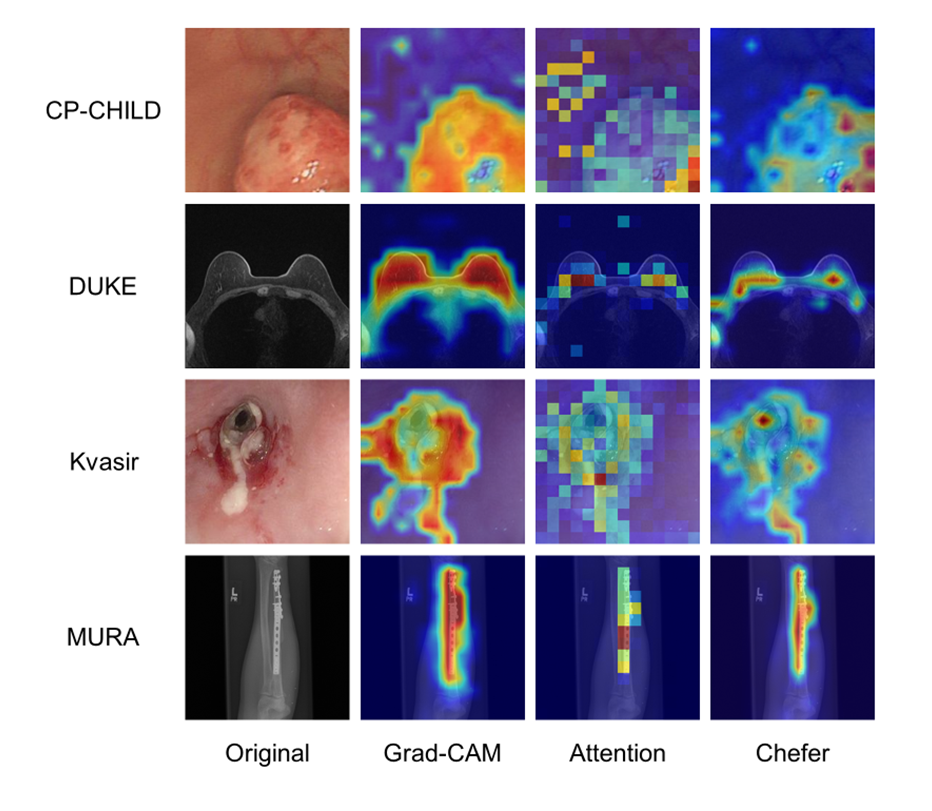This repository contains the implementation of the project "Are attention maps a solution to the interpretability crisis in AI-assisted medical imaging?". In this project, we investigated the reliability of attention maps of the Vision Transformer (ViT) as an interpretability method under the context of medical image diagnosis. This repository provides Python codes to reproduce interpretability results of attention maps and two different methods: Grad-CAM and the Chefer method.
We recommend to use Python virtual environmnet using Conda.
You can install the required dependencies:
conda env create -f requirements.yaml
You can run main.py to generate interpretability maps and final evaluation results over all datasets and interpretability methods.
The structure of this repository is as follows:
-
Code - src/ folder contains necessary python files to generate interpretability maps (including attention maps) and evaluate different interpretability methods.
-
Data - data/ folder contains placeholding directories only without any image data. You may follow the instruction to download medical image datasets that we used.
-
Checkpoints - weights/ folder is a placeholding directory as well.
.pthfiles of our selected trained models and MAE & DINO pre-trained ViT weights should be put in this directory.
To evaluate interpretability methods, ViT-B/16 models are trained to achieve the state-of-the-art benchmark performance for each medical imaging dataset. 4 different initalization methods are used: random (i.e., from scratch), supervised, DINO, and MAE. Note that they are pretrained on ImageNet, except for the random initalization.
The table below shows the hyperparameter settings used to train each model of this project. Saved epoch means the epoch of model selection in which early stopping based on validation loss happened. You can use these to reproduce our training results.
| Dataset | Model init. | Optimizer | Learning Rate | Momentum | Weight Decay | Scheduler | Total Epoch | Saved Epoch | Batch Size |
|---|---|---|---|---|---|---|---|---|---|
| CP-Child | Random | Adam | 0.00001 | 0.9 | 0.0001 | CosineAnnealing | 20 | 18 | 64 |
| Sup | Adam | 0.00001 | 0.9 | 0.0001 | CosineAnnealing | 20 | 5 | 64 | |
| DINO | Adam | 0.00001 | 0.9 | 0.0001 | CosineAnnealing | 20 | 12 | 64 | |
| MAE | Adam | 0.00001 | 0.9 | 0.0001 | CosineAnnealing | 20 | 11 | 64 | |
| DUKE | Random | SGD | 0.1 | 0.3 | 0 | CosineAnnealing | 200 | 79 | 64 |
| Sup | SGD | 0.03 | 0.1 | 0 | CosineAnnealing | 20 | 2 | 64 | |
| DINO | SGD | 0.005 | 0.1 | 0 | CosineAnnealing | 15 | 5 | 64 | |
| MAE | SGD | 0.03 | 0.1 | 0 | CosineAnnealing | 15 | 2 | 64 | |
| Kvasir | Random | SGD | 0.08 | 0.1 | 0 | CosineAnnealing | 25 | 24 | 32 |
| Sup | SGD | 0.0018 | 0.1 | 0 | CosineAnnealing | 25 | 8 | 32 | |
| DINO | SGD | 0.0012 | 0.1 | 0.0001 | CosineAnnealing | 25 | 20 | 32 | |
| MAE | SGD | 0.02 | 0.1 | 0.0001 | CosineAnnealing | 25 | 25 | 32 | |
| MURA | Random | SGD | 0.001 | 0.9 | 0.0001 | CosineAnnealing | 200 | 180 | 64 |
| Sup | SGD | 0.001 | 0.9 | 0.0001 | CosineAnnealing | 100 | 9 | 64 | |
| DINO | SGD | 0.001 | 0.9 | 0.0001 | CosineAnnealing | 150 | 43 | 64 | |
| MAE | SGD | 0.001 | 0.9 | 0.0001 | CosineAnnealing | 100 | 35 | 64 |
This is another option to reproduce our interpretability results. You can just directly download the checkpoints, put them into weights/ folder, and load them to run main.py.
| Dataset / Method | Random | Supervised | DINO | MAE |
|---|---|---|---|---|
| CP-Child | Download | Download | Download | Download |
| DUKE | Download | Download | Download | Download |
| Kvasir | Download | Download | Download | Download |
| MURA | Download | Download | Download | Download |
Chefer, H., Gur, S., & Wolf, L. (2021). Transformer Interpretability Beyond Attention Visualization. Proceedings of the IEEE Computer Society Conference on Computer Vision and Pattern Recognition, 782–791. https://doi.org/10.1109/CVPR46437.2021.00084
Dosovitskiy, A., Beyer, L., Kolesnikov, A., Weissenborn, D., Zhai, X., Unterthiner, T., Dehghani, M., Minderer, M., Heigold, G., Gelly, S., Uszkoreit, J., & Houlsby, N. (2020). An Image is Worth 16x16 Words: Transformers for Image Recognition at Scale. arxiv. https://doi.org/10.48550/arXiv.2010.11929
Selvaraju, R. R., Cogswell, M., Das, A., Vedantam, R., Parikh, D., & Batra, D. (2017). Grad-CAM: Visual Explanations from Deep Networks via Gradient-Based Localization. Proceedings of the IEEE International Conference on Computer Vision, 618–626. https://doi.org/10.1109/ICCV.2017.74
